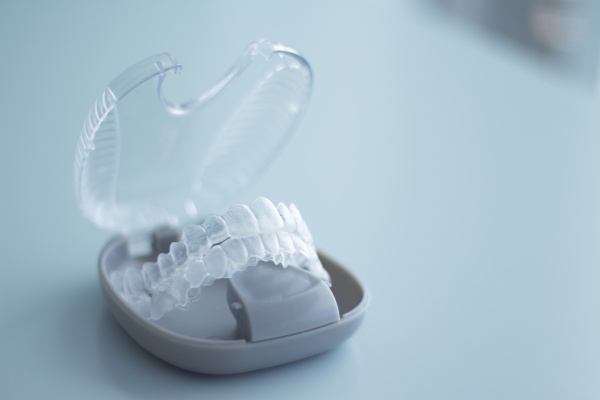Adjusting to Life With Invisible Braces

Getting invisible braces is an exciting step in fixing crooked teeth and correct bite problems. There are many benefits to choosing this treatment over traditional metal braces. Still, it can take some time to become accustomed to how they feel. Luckily, you can follow some effective strategies to help you have a positive experience and get the results you are looking for. Your dentist can also recommend different ways for the aligners to feel good.
Choosing Invisalign® aligners
There are different options when it comes to invisible braces. Moving crooked teeth into the right places does not have to involve clunky metal that everyone notices. Invisalign is a common, popular treatment that comes in the form of clear, plastic trays that fit over the patient’s teeth. Gradually, the trays move the teeth by putting constant pressure on them. Patients get new trays at every dental appointment, usually every couple of weeks. The total treatment time is usually no more than 18 months.
Take them out to eat
Invisalign invisible braces are more comfortable than metal braces. The trays will not irritate the gums and cause sores as traditional braces will. It can still be difficult to get used to them. The good news is that patients will not have to wear them 24 hours a day. In fact, the dentist will advise the individual to remove the trays at mealtime. Doing this will eliminate the risk of food getting trapped under the appliance.
Wear them otherwise
It can be tempting to remove the invisible braces more often. People may look for every chance possible to take them out and set them aside for a while. This will delay the total treatment time and limit the effectiveness of the Invisalign trays. It will also make it more difficult for the patient to get used to how the appliance feels and works in the mouth. Other than for eating, drinking, and cleaning the tray, the patient should keep the aligners in at all times.
Keep up on appointments with the dentist
The patient’s dentist will work closely with the person to ensure that the invisible braces are doing their job well. These follow-up appointments will address any pain or discomfort the patient is experiencing. Perhaps even more importantly, at the dental appointments, the dentist will give the patient new trays or adjust the current ones. There could be issues with the trays that the patient does not realize. Missing out on appointments will eliminate the chance for the dentist to examine the patient and address these concerns.
Invisible braces make sense
Traditional metal braces can be difficult for people to wear. They can be uncomfortable, and they stand out. Clear aligners are practically impossible to detect, and the treatment can be just as effective. You need to do your part to ensure that the treatment helps you achieve your goals — both cosmetically and for your wellness. Talk to your dentist today about implementing these tips into your daily routine. You can also ask any questions and talk about any concerns at your next visit.
Request an appointment here: https://drcalldental.com or call Dr. Call Dental Center at (706) 425-6240 for an appointment in our Dalton office.
Check out what others are saying about our services on Yelp: Read our Yelp reviews.
Related Posts
Gum disease is one of the most common oral health issues dentists encounter in patients of all ages. It can range from mild gum irritation to severe conditions that affect the tissues and bones supporting your teeth. The root cause of gum disease is typically the accumulation of plaque on the teeth and gums. Understanding…
Dental bonding is one of the treatment options available for individuals seeking to improve their smile. A report by the American Dental Association found that almost 33% of young adults avoid smiling due to the condition of their teeth. This statistic shows the effect of dental aesthetics on one’s social life and self-esteem. This article…
Chipping needs dental bonding so that the tooth can regain its proper structure. Trauma and decay are the most common causes of dental chipping. Both cause the tooth to weaken and break easily. Your dentist must use this treatment to correct the damage right away. Here are the details on using dental bonding to repair…
When sudden dental pain occurs, an emergency dentist can provide critical relief and timely treatment. A toothache often appears unexpectedly, disrupting daily activities or restful sleep at night, signaling that you need urgent dental care. Understanding what steps to take when this type of pain occurs can help prevent further complications to your teeth and…


